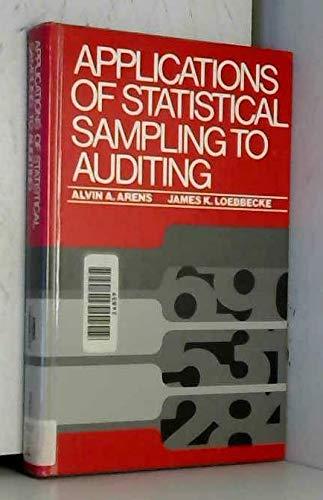Before the sample of inventory for pricing was selected for Armandy Department Stores (see problem 7-22), a
Question:
Before the sample of inventory for pricing was selected for Armandy Department Stores (see problem 7-22), a new staff member, Joe Krebbs, who had taken statistical sampling in auditing in college, came up with two ideas that he felt were more efficient than unstratified mean-per-unit.
The first idea was to use stratified rather than unstratified mean-per-unit. He took the position that the use of stratification would reduce the standard deviation of the population by putting items of similar value in the same stratum. After looking at last year’s inventory listing, he concluded that the following three strata should be used:
Stratum 1 : Any inventory item, after extension of price times quantity, valued in excess of \($3,000\) Stratum 2: Any inventory item valued between \($1,000\) and \($3,000\) Stratum 3: Any inventory item valued at less than \($1,000\) The partner on the engagement felt that the idea was good but that it was not possible, because of the rule that the population size for each stratum had to be known. Since inventory had not been extended yet, the population size for each stratum could not be determined.
Joe is somewhat discouraged by now but has decided to explore the second idea further anyway. His plan is to use stratified difference or ratio estimation. He wants to use last year’s listing at retail as the recorded value because there are individual values and a total. The audited value will be this year’s historical cost value, and the difference for a sample item will be the difference between last year’s retail value and this year’s audited value. He wants to use stratified difference or ratio estimation to reduce the standard deviation.
The partner, who prides himself on shooting holes in other people’s plans, informs Joe that the second idea won’t work either. He says, “Some of last year’s inventory items are no longer being stocked, and there are new items that weren’t stocked last year. It wouldn’t be practical to find a sampling unit that would properly define the population. Unstratified mean-per-unit is the best way to go in this case. Joe, you are now learning the difference between theory and practice.”
Required :
a. Devise a plan for using stratified mean-per-unit sampling that would answer the partner’s objections and meet the requirements of stratified sampling. Evaluate implementation problems you might encounter. Under what circumstances is the plan apt to be an improvement over unstratified mean- per-unit estimation?
b. Devise a plan for using stratified difference or ratio estimation that would answer the partner’s objections and meet the requirements of stratified sampling. Identify potential implementation problems. Under what circumstances is the plan apt to be an improvement over both stratified and unstratified mean-per-unit estimation ?
Problem 7-22:
Armandy Discount Stores is a large department store catering primarily to low-income people. More than 20,000 different products are kept in inventory and sold by the store. Management has followed the practice of using the retail inventory method in previous years. A team of outside professional counters came into the store after closing and took a complete physical count of units and prices at retail by the use of tape recorders. The information on the tape recorders was then keypunched. The inventory value at retail was determined by means of the computer. Additional calculations were made to convert the retail inventory to cost. Management feels that this entire process is more costly than is desirable, considering the need to have staff members of the CPA firm involved at every step.
A partner in the CPA firm believes it may be possible to use statistical sampling to determine the inventory value at cost. Further discussion with Armandy’s management indicates that no perpetual records exist, but all merchandise purchases are computerized at the time of acquisition, including product description and unit cost. The decision is made to use a line item on the product-description computer output list as the sampling unit for mean- per-unit estimation. There are 24,856 lines on the list.
The recorded value of last year’s inventory was SI,852,627. The audit partner and management decide they are willing to accept the point estimate as the recorded value if it is within \($75,000\) of the true value. They do not want more than a 5% risk that it is misstated by more than \($75,000\). Based on last year’s recorded inventory, the standard deviation is estimated as \($55\).
Required :
a. Evaluate the use of unstratified mean-per-unit estimation in this situation. What other alternatives should be considered ?
b. Evaluate the decision to use line items on the product-description computer output list as the sampling unit. What problems is the auditor likely to encounter ?
Should interval estimation or hypothesis testing be used in this situation? Explain.
Calculate the appropriate sample size, given the information provided to this point.
For approximately 10% of the items included in the random sample, there was no actual inventory on hand. How should these items be included in (or excluded from) the statistical results ?
Assume that a random sample of 1,100 items was selected. The total value of the inventory at historical cost was \($87,203\). The total of the individual values squared was \($9,871,405\). Calculate the confidence interval for the population. Is an adjusting entry appropriate at this point ? If so, state what the entry should be. If not, what action is necessary ?
Step by Step Answer:

Applications Of Statistical Sampling To Auditing
ISBN: 9780130391568
1st Edition
Authors: Alvin A. Arens, James K. Loebbecke






